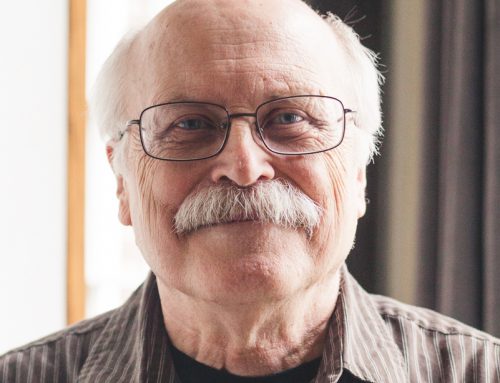Katherine Hepburn plays Rose in the 1951 movie, The African Queen. Rose is a strict missionary, forced to flee her mission village aboard a rickety boat steered by profligate captain Charlie, played by Humphrey Bogart.
Rose is prim, starchy, and armed with doctrines. She rebukes Charlie for his loose pragmatism and unshaved chin. Charlie, on the other hand, is a creaturely man. He ignores doctrine, obeys instinct, and flouts Rose’s “unnatural” principles. Finishing a bottle of gin, Charlie tells Rose, “A man takes a drop too much once in a while. It’s only human nature.”
“Nature,” replies Rose, “is what we are put in this world to rise above.”
These two characters have been sparring within human souls from time immemorial. Call the battle what you will: conviction versus emotion, intellect versus appetite. Whatever the name, the conflict is a central plot-point of human life. When do we heed our inner yearning? What yearnings ought be reproved by principle? And the thorniest question of all: How?
Today, many schools and even some churches retain an Enlightenment view of human beings. According to this view, every man was an autonomous scientist who reasoned his way to goodness. Does your inner life judder? Just think logically, harder.
If our experience wasn’t enough to refute this view, cognitive research might. As David Brooks reports, “The past half-century of cognitive science has shown that [the autonomous rationalist] doesn’t exist … emotions play a central role in decision-making, the vast majority of thought is unconscious, and our minds are riddled with biases.”
The Enlightenment vision of humanity was too narrow. We are not merely rational beings. We are dependent creatures moved by passions. Earlier philosophers and theologians recognized the full-orbed nature of human life. They formulated intricate insights into the interworkings of the heart and mind.
The ancient Stoics did so particularly.[ref]The Epicureans, philosophical rivals to the Stoics, also developed deep psychological insights. For the sake of brevity, I have confined this article to the Stoics.[/ref] Today’s popular image of the Stoic is of a heartless, marbled nobleman. That picture is imprecise. Yes, the Stoics sought to suppress their emotions. Yet these Greeks and Romans developed a deep vision about the function of emotions upon the mind.
Marcus Aurelius, a Stoic, was emperor of Rome for twenty years. As the most powerful man in the world, one loose word from him could strike down a man’s life. Keen to restrain his temper, Marcus Aurelius wrote a book about controlling his emotions. He called it To Myself (today’s translation is titled Meditations). In it, Marcus Aurelius constantly reminded himself not to react to the “externals” of life but to focus on what is divine and permanent.
Other men’s ingratitude, disloyalty, anger, and selfishness—these were externals. These fell beyond his control, but his internal reactions could be regulated. “If you are distressed by anything external,” he wrote, “the pain is not due to the thing itself, but to your own estimate of it; and this you have the power to revoke at any moment.” This observation and many others in Mediations provide potent reminders about the power of the human will.
But even the strongest Stoic was not immune to the sting of externals. Marcus Aurelius observed that an ungrateful friend or an unfaithful spouse can strike like a wasp and prompt anger and sorrow. How is one to remain tranquil despite such stings? By recognizing the two “movements” of the emotions.
To understand these two movements, imagine visiting a zoo and having a cobra strike at you from behind a thick pane of glass. Although you “know” that the snake cannot harm you from behind the glass, you will still flinch. The flinch feels wild and uncontrollable because it disturbs what was truly divine to the Stoics—our reason.
Some Stoics, like the Greek Chrysippus (279–206 b.c.), believed this first movement was not cerebral, but physical. Cognitive research has largely confirmed his insight. With the development of CAT and PET scans, researchers can peer at the human brain and nervous system during moments of intense stress. When a cobra strikes, the brain-stem overrides the logic and language-making part of the brain (the cerebral cortex) to autopilot us away from danger. In other words, our capacity to act logically is overwhelmed by the urge to fight, flee, or freeze.[ref]Some English phraseology captures the swirling sensation caused by brain-stem override: “I was so scared I couldn’t see straight.” “She stormed out of the office.” “He flipped his lid.” “I saw red.”[/ref]
After this first movement, however, a second arrives. The Stoics believed this second movement could be understood and controlled by inner reflection, guided by the right ideals. (Character, virtue, rationality, and kindness were four things considered permanent and valuable.) The Stoics spent their efforts stymieing the first movement of the emotions by reasoning about the second.
Stoic and Christian teachings share much ethical territory. Both Stoics and Christians pursue divine things, not the things of this world. Both teach that hardships can improve character. Both favor self-restraint. Both share some metaphysical beliefs. (The Apostle Paul quotes Stoic poetry in Athens: “For in him we live, and move, and have our being; as certain also of your own poets have said, ‘For we are also his offspring’” [Acts 17:28].)
This shared territory is so vast that several historians believe Stoicism tilled the soil for Christianity to be accepted within the Roman Empire. But Stoics and Christians differed in two important ways: first, they differed in their view of emotions; and second, they differed in their expectation of life after death.
The Stoics and Christians differed in their approach to emotions. Although both the Christians and the Stoics prized internal restraint, the Stoics were obsessed with it. The Romans, deeply influenced by Stoic thought, had seventeen words for self-control,[ref]We can understand this obsession with self-control by remembering the difficulties of the ancient urban world. Most Stoics lived in societies that would be unbearable to most modern people. Moreover, their societies had few resources for improvement. Self-control was not only reasonable, but it might have felt like the only choice for a passionate thinking person.[/ref] and they spent much willpower toward muffling and removing strong sentiments. “The Stoics wanted to extirpate all emotions,” writes Keith Oatley in Emotions: A Brief History. The result was “a rather shocking indifference to everything outside themselves.” Their view of “kindness,” for example, resembled something more like modern cordiality; Stoic kindness was detached and quite different than Christian kindness (or compassion).
The consequence was a Roman culture devoid of pity. “Especially among the philosophers, mercy was regarded as a character defect and pity as a pathological emotion: because mercy involves providing unearned help or relief, it is contrary to justice” (Rodney Stark, The Triumph of Christianity, 112).
On this point, Christians and Jews in the first three centuries of the Roman Empire differed sharply from the Stoics. Jews and then Christians came to see compassion as part of the essence of the divine. Philo of Alexandria (25 b.c.e.–50 c.e.), a Hellenized Jew, contended that the emotion “most closely related and akin to the rational soul” is pity. Later, the Christian Lactantius (250–325 c.e.) said that the Stoics were wrong to suffocate emotions, because emotions were “planted in us by nature and have a purpose” (see David Konstan, Pity Transformed, 121).
Christians did not seek to strip themselves of emotions but to shape them to resemble Jesus. Jesus Christ was not an indifferent ascetic. According to the Gospels, Jesus felt anger, zeal, distress, agony, love, sadness, and desire. Moreover, the Gospels frequently tell us that Jesus felt compassion. He felt compassion for lepers, for the blind, for the starving crowds, for a widow who lost her only son, and for those “who were like sheep without a shepherd.” For these people, Jesus sighed, groaned, sobbed, loved, rejoiced, grieved, and was deeply moved.
As Jesus had compassion, so also did his followers. Early Christians were so committed to relieving physical suffering that, according to historian Paul Johnson, they “ran a miniature welfare state in an empire which for the most part lacked social services” (History of Christianity, 75). Surely this compassion was perfumed by the Christian hope for a future life. I will expand upon this second difference between the Christians and Stoics in a moment, yet it needs mentioning now. During the early Roman Empire, Christians brought a fresh hope to a civilization running out of breath, where philosophers “prattled vaguely about the exhaustion of virtue in a world growing old” (Charles Norris Cochrane, Christianity and Classical Culture, 155).
The Christians believed that death was not the end. This hope provided a deep-seated liberty from the ominous power of death. Rather than storing up treasures on earth, where moth and rust destroy, believers laid up treasures in heaven.
This liberty from death generated a revolution of compassion by freeing believers to be compassionate. The Apostle Paul says that he longs for the Philippians “with the compassion of Christ” (1:8). He urges Roman believers to “rejoice with those who rejoice and weep with those who weep” (12:15). The author of Hebrews urges Jewish converts to “remember those in prison as if you were together with them in prison, and those who are mistreated as if you yourselves were suffering” (13:3).
Like the Stoics, the authors of the New Testament assumed that emotions can be recognized and shaped. On this count, both Stoics and Christians would repudiate the “Captain Charlie School” of psychology that presumes we are prisoners to our inner whirlwinds: What feels right is right. Both Stoics and Christians would reject such childishness. But unlike the Stoics, the early Christians did not adopt the “Missionary Rose School”; they did not believe that nature was “what we are put in this world to rise above.” On the contrary, they believed our inner nature could be recognized and shaped with charity.
I wrote this article at New Day Bakery where an old piano sits in the dining area. While I was writing, a homeless man came in and plunked down a dirty sleeping bag on the piano bench. I knew nothing about the man but carelessly judged him: “This is what happens when people make bad choices,” I thought. Then the man put his fingers on the piano keys and started to play “Unchained Melody” by the Righteous Brothers. I was moved. And I was ashamed. I imagined this man playing scales as a boy. I imagined a mother who loved him, playmates who cared for him. But now the poor man was alone.
Every believer desires (on good days) an inner emotional life that conforms to God’s truth and God’s plans. But our internal lives often betray our spiritual convictions, leaving us to feel like vipers with butterfly wings. Some Christian teachers deny this internal struggle. Some peddle the doctrine of the “victorious Christian life” and preach that faith will result in material prosperity and internal peace. If we truly believe, they say, we will be financially and psychologically blessed. Such silliness could only thrive in a wealthy country during a media age. Any graph of the Christian life includes ups and downs, successes and failures, prosperities and poverties.
So then, we’ve seen how Stoics and Christians differed in their view of the inner emotional life. Let me now say more about the second great difference between the Roman Stoics and the early Christians: The Romans were pessimistic about the future life;[ref]Some Romans who followed the cult of Osiris believed in an after death resurrection. But their numbers were small, and most were cynical regarding life after death. Some of their burial inscriptions depicted their pessimism, bidding the deceased happiness with the worms.[/ref] the Christians were optimistic. Christian teaching presented a constant hope in a future reunion with God—in spite of the struggles of the Christian life here and now.
Christians believed the Messiah had been raised from the dead. His resurrection was a promissory note (“the first fruits”) for Christian resurrection. And Christians knew to put their hope there. One ancient Christian burial tomb reads as follows:
May the God of the spirit and of all flesh,
Who has overcome death and trodden Hades under foot,
permit this soul of Father Schenute to attain rest
in the bosom of Abraham.
Critics accuse Christians of invoking this resurrection fairy tale as a sedative against living in this world. Undoubtedly, many religious persons use the resurrection as an excuse to neglect this world. But the Scriptures teach a hope that is not an escape from this life but rather is an indicator of what will happen in the next: “Many that are first will be last, and the last first” (Matthew 19:30).
To calculate the internal consequence of this hope is difficult. But, like a steady wind, it is evidenced by a full sail. Surely this hope shapes the inner life toward joy and thankfulness and the outer life toward compassion and practical charity. The Jewish and Christian legacy deeply shaped the psyche of the West so that today we live in a culture that prizes compassion.
Unfortunately, however, the modern concern for suffering and compassion has stepped past humanitarianism in some arenas. It has become an obsession with victimhood that borders on the pharisaical. This compassion does not rise from a desire to aid others. Instead it rises from a need to justify ourselves and exceed our rivals. Parts of our society are clouded by this fog, which encourages lenience in all circumstances and denounces strength as the taproot for tyranny. This is not Christian compassion. This is instead “the secular mask over Christian love” (René Girard, I See Satan Fall Like Lightening, 165).
Despite this overtide, we should be thankful that we live in a compassionate culture. By all historical standards, the Western world is as safe, healthy, and just as any in human history. We should guard against cloistered comfort, however, because many countries outside of the developed world still endure maladies that rival those of the Roman Empire. And closer to home, not all our neighbors are healthy, safe, or treated justly. The need for compassion is no less needed than when the Stoics and early Christians differed over principle and emotion. Much of what passes today as peace is muted pain because many of today’s griefs were inflicted secretly and are endured quietly. Thus, as the old saying goes, “Be kind, for everyone you meet is fighting a great battle.”






